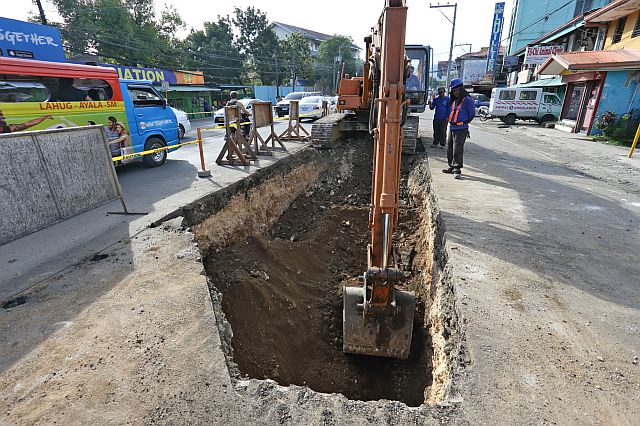
This 2016 file photo shows construction work on a drainage project that starts along Pope John Paul II Avenue in Barangay Mabolo, Cebu City. Cebu City still faces flooding problems to this day pushing the city council to call for a comprehensive drainage master plan. CDN FILE PHOTO
CEBU CITY, Philippines―Cebu City’s drainage master plan is an outdated document that cannot address current problems and issues.
This was the direct answer of Cebu City’s Department of Engineering and Public Works (DEPW) to the Cebu City Council as the legislative body continues to tackle an integrated and detailed solution to address flooding and other drainage-related issues faced by the city.
In a letter addressed to the Cebu City Council, City Engineer Kenneth Carmelita Enriquez described Cebu City’s masterplan as “outdated” and “useless” because it was created in 2004 or 15 years ago.
Enriquez said the master plan is no longer relevant and could not be implemented in 2019 because Cebu City underwent several changes and developments, which requires an updated master plan.
Enriquez said Cebu City would sill need to embark on another set of studies in order to craft a master plan that will address the present issues faced by the growing metropolis.
READ: City Council calls for comprehensive drainage master plan for Cebu
READ: Cebu City needs P50 million for drainage master plan —Cuenco
Enriquez said Cebu City can turn to the drainage master plan of the Department of Public Works and Highways Central Visayas (DPWH-7), an integrated master plan for Metro Cebu, which also covers its neighboring cities.
With the more recent master plan of the DPWH, which was completed in 2016, Enriquez said Cebu City can go directly to the “detailed engineering design,” which details where Cebu City figures in the bigger drainage picture.
In a story published in the Philippine News Agency on February 7, 2019, Luis Paredes, project manager of DPWH-7 Flood Control Management Cluster, said that the agency is “ready to implement P23.5 billion worth of infrastructure projects” that will address the flooding problems in Metro Cebu from 2020 to 22.
Paredes was quoted saying that the infrastructure projects were recommended in the “Metro Cebu Integrated Flood and Drainage System Master Plan.”
The plan was initiated by the Metro Cebu Development and Coordination Board (MCDCB).
MCDCB is a body composed of businessmen, civil society organizations, local government officials and government agencies and is mandated to formulate development plans for the Metro Cebu area and coordinate their implementation.
Three years ago, in July 2016, former mayor Tomas announced that Cebu City is out of the Mega Cebu program, which is aimed at mobilizing Cebu local governments into mapping and implementing shared sustainable projects for their constituents.
The program was also initiated by the MCDCB.
READ: Tom: Cebu City out of Mega Cebu
Enriquez of Cebu City’s DEPW said the DPWH master plan includes the neighboring cities of Mandaue and Talisay.
She said utilizing the DPWH master plan is “much more viable” because some of the waterways in Cebu City are shared with its adjacent cities.
The three chief executives―Cebu City Mayor Edgardo Labella for Cebu, Mandaue City Mayor Jonas Cortes for Mandaue, and Talisay City Mayor Gerald Anthony Gullas―previously agreed on a comprehensive and integrated drainage system for the three cities.
READ: Cities of Cebu, Talisay, and Mandaue to discuss traffic and flooding woes
In Cebu City, Enriquez said the DEPW continues to declog the present waterways of the city as a temporary solution to the flooding problems.
She urged the public to stop using throwing garbage especially plastic wastes in the waterways.
She said plastic waste constitutes 75 percent of the reason why rivers and canals are clogged.
“Most of the drainage in the city are fully clogged so we need to remove a lot of garbage daily,” said Enriquez. / celr

